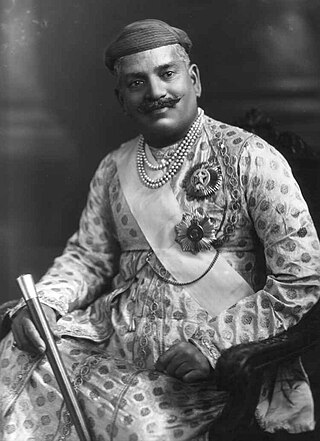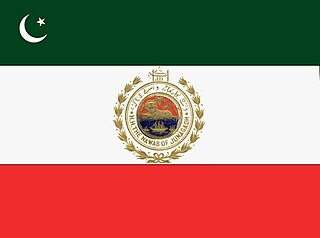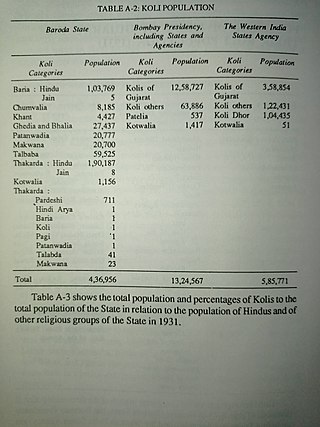Related Research Articles
Patel is an Indian surname or title, predominantly found in the state of Gujarat, representing the community of land-owning farmers and later businessmen, agriculturalists and merchants. Traditionally the title is a status name referring to the village chieftains during medieval times, and was later retained as successive generations stemmed out into communities of landowners. There are roughly 500,000 Patels outside India, including about 150,000 in the United Kingdom and about 150,000 in the United States. Nearly 1 in 10 people of Indian origin in the US is a Patel.

Bahuchara Mata is a Hindu goddess of chastity and fertility in her maiden aspect, of the incarnation of the Hinglaj. The goddess grants favours, especially of male children, and cure diseases. Like other divinities in Gujarat and Rajasthan, Bahuchara is of Charana origin. She is also considered the patroness of the hijra community. Her primary temple is located in Becharaji town in Mehsana district of Gujarat, India.
Kheda, also known as Kaira, is a city and a municipality in the Indian state of Gujarat. It was former administrative capital of Kheda district. India's First Deputy Prime Minister Vallabhbhai Patel Was Born In Kheda District of Gujarat State. Kheda city is famous for tobacco farming. The nearest railway station is Mahemadavad Kheda Road. The nearest airport is Ahmedabad airport. The nearest bus station is "Kheda Bus Station".

Sayajirao Gaekwad III was the Maharaja of Baroda State from 1875 to 1939, and is remembered for reforming much of his state during his rule. He belonged to the royal Gaekwad dynasty of the Marathas which ruled parts of present-day Gujarat.
The history of Gujarat began with Stone Age settlements followed by Chalcolithic and Bronze Age settlements like Indus Valley civilisation. Gujarat's coastal cities, chiefly Bharuch, served as ports and trading centers in the Nanda, Maurya, Satavahana and Gupta empires as well as during the Western Kshatrapas period. After the fall of the Gupta empire in the 6th century, Gujarat flourished as an independent Hindu-Buddhist state. The Maitraka dynasty, descended from a Gupta general, ruled from the 6th to the 8th centuries from their capital at Vallabhi, although they were ruled briefly by Harsha during the 7th century. The Arab rulers of Sindh sacked Vallabhi in 770, bringing the Maitraka dynasty to an end. The Gurjara-Pratihara Empire ruled Gujarat after from the 8th to 10th centuries. While the region also came under the control of the Rashtrakuta Empire. In 775 the first Parsi (Zoroastrian) refugees arrived in Gujarat from Greater Iran.

Fatehsinghrao Prataprao Gaekwad II was an Indian politician, cricketer, and titular Maharaja of Baroda from 1951 until 1988. In the 26th amendment to the Constitution of India promulgated in 1971, the Government of India abolished all official symbols of princely India, including titles, privileges, and remuneration.
Dabhade surname signifies Maratha and Koli clans found largely in Maharashtra, India. The Maratha Dabhades were originally centered on Talegaon Dabhade, but became the chiefs of Gujarat. They held the hereditary title of Senapati (commander-in-chief) and several jagirs in Gujarat until 1751. That year, Umabai Dabhade and her relatives were arrested for a rebellion against the Peshwa, and were stripped of their titles.
Thakar, is a family name referring to the descendants of Kashiraj Thakar, an 11th-century Kashmiri Brahmin who moved to the region of Saurashtra, Gujarat to spread and maintain Hinduism on the request of the Jayasimha Siddharaja, a Hindu Chaulukya king who ruled modern-day Gujarat until 1143. The family rose to prominence within Saurashtran nobility throughout the 12th-19th centuries as Diwans.

Baroda State was a princely state in present-day Gujarat, ruled by the Gaekwad dynasty of the Maratha Confederacy from its formation in 1721 until its accession to the newly formed Dominion of India in 1949. With the city of Baroda (Vadodara) as its capital, during the British Raj its relations with the British were managed by the Baroda Residency. The revenue of the state in 1901 was Rs. 13,661,000. Baroda formally acceded to the Dominion of India, on 1 May 1949, before which an interim government was formed in the state.

Vav is a town and the headquarters of Vav Taluka in Banaskantha district in Gujarat state of India. Vav is the largest taluka of the district.

Junagarh or Junagadh was a princely state in Gujarat ruled by the Muslim Babi dynasty in India, which acceded to the Dominion of Pakistan after the Partition of British India. Subsequently, the Union of India annexed Junagadh in 1948, legitimized through a plebiscite orchestrated the same year.

Baria, or Baraiya,Bareeya and Bariya is a clan (Gotra) of the Koli caste found in the Indian State of Gujarat and Dadra and Nagar Haveli and Daman and Diu. the Devgad Baria was their Stronghold or given their name to Baria State in Gujarat. according to the historian Y.V.S Nath, the ruling royal family of Baria State is original Koli by caste but later they claimed to be of Rajput origin to be in high status among other Princely States.

The Koli is an Indian caste found in Rajasthan, Himachal Pradesh, Gujarat, Maharashtra, Uttar Pradesh, Haryana, Karnataka, Odisha and Jammu and Kashmir states in India. Koli is an agriculturist caste of Gujarat but in coastal areas they also work as fishermen along with agriculture. In the beginning of 20th century, the Koli caste was recognised as a denotified tribe under Criminal Tribes Act by the Indian Government because of their anti-social activities during World War I.

The Mewasi, or Mevasi, Mehwasi is a title of Koli caste found in Indian state of Gujarat. The Koli chieftains who ruled over villages populated by turbulent Kolis were titled as Mewasi because of their rebellious activities against Maratha and Mughal rulers.

Jambughoda State, previously known as Narukot and Tokalpur state, was a small princely state in India during the time of the British Raj. Its last ruler acceded to the Union of India on 10 June 1948.
The Hadol is a village and former non-salute princely state in Gujarat, Western India.
Sumant Mehta was a physician, independence activist and social worker from 20th-century India. Educated in London, he served as a personal physician of the Gaekwad rulers of Baroda State before entering public life in 1921. Along with his wife Sharda Mehta, he was involved in social and political activities.
Kankrej is a city and Municipal council in Banaskantha district in the Gujarat state of India.

The Chunvalia, or Chuvalia, Chunwalia is a subcaste of the Koli caste, found in the Indian state of Gujarat. The Chunvalia Kolis were the first Indian caste to adopt the game of cricket in India. Chunvalia Kolis were classified as a Criminal Tribe under Criminal Tribes Act by government of the British Raj because of their purported anti-social behaviour and activities, such as alleged dacoity in Gujarat. During the First World War, Chunwalia Kolis were enlisted as soldiers in British Indian Army by the Bombay government of British India.
References
- ↑ Copland, Ian (1982). The British Raj and the Indian Princes: Paramountcy in Western India, 1857-1930. New Delhi, India: Orient Longman. p. 90. ISBN 978-0-86131-210-8.
- ↑ Saṅghavī, Nagīnadāsa Purushottamadāsa (1995). Gujarat: A Political Analysis. New Delhi, India: Centre for Social Studies. p. 108.
- ↑ Rajyagor, S. B. (1982). History of Gujarat. New Delhi, India: S. Chand. p. 422.
- ↑ Lobo, Lancy (1995). The Thakors of North Gujarat: A Caste in the Village and the Region. New Delhi, India: Hindustan Publishing Corporation. p. 109. ISBN 978-81-7075-035-2.
- ↑ Dharaiya, Ramanlal Kakalbhai (1970). Gujarat in 1857. New Delhi, India: Gujarat University. pp. 38–40.